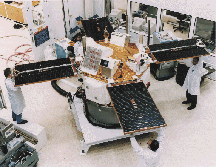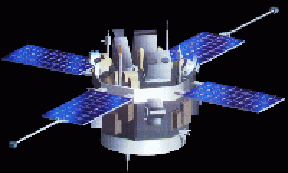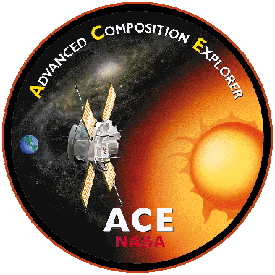The official ACE logo
Click on image for full size
Image courtesy of NASA
ACE Mission Page
Have you ever wondered what you are made of? Where did the
elements come from that make up your body? The elements that make up your body are the same elements found on the Earth. Where did those Earth elements come from? Most would say that the building blocks of the Earth came from the Sun...and that the Sun's material came from the
Milky Way galaxy, and the galaxy's material came from the universe...
So you see, if we can better understand what makes up the universe, our galaxy, and our Sun, we can understand what makes up our solar system, the Earth, and even our own bodies! Now there is a spacecraft designed with instruments to do just this! The ACE (Advanced Compostion Explorer) was launched in August 1997. The main goal of ACE is find out about what makes up Sun, our solar system and our galaxy.
What do you think of when someone says, "how's the weather?" Do you say it's rainy or hot or windy? Well, there's another kind of weather you probably didn't think of - spaceweather! The ACE satellite acts as a spaceweather station while in orbit. It helps scientists make forecasts (just like here on Earth!) and predict stormsthat are caused by explosions on the Sun - coronal mass ejections.
The ACE mission has had an extremely successful mission so far. It recently (June 1998) made some exciting discoveries about coronal mass ejections. Here's an animation which describes more...
You might also be interested in:

An element (also called a "chemical element") is a substance made up entirely of atoms having the same atomic number; that is, all of the atoms have the same number of protons. Hydrogen, helium, oxygen,
...more
A coronal mass ejection (CME) happened on the Sun last month. The material that was thrown out from this explosion passed the ACE spacecraft. ACE measured some exciting things as the CME material passed
...more
The Leonids meteor shower will be the biggest and the brightest on November 17th this year. The meteors could damage satellites in orbit. If a tiny meteor hits a satellite, the meteor can mess up the electronics
...more
Scientists have found where cosmic rays come from! The rays are made of atoms. These atoms are flying through space at speeds close to the speed of light. Until now, scientists didn't know where they
...more
The Hubble Space Telescope (HST) is really neat! It was first launched in 1990, but scientists started building it in the 1970's! We have found all kinds of objects like stars, nebulae and galaxies. The
...more
Apollo 11 was the first mission that landed a person on the moon. On July 16, 1969, the U. S. rocket Saturn 5 was launched carrying the lunar landing module Eagle. The Eagle was released and it reached
...more
Apollo 12 was launched on Nov. 14, 1969 and arrived at the Moon three days later. Astronauts Charles Conrad and Alan Bean descended to its surface, while Richard Gordon remained in lunar orbit aboard the
...more















